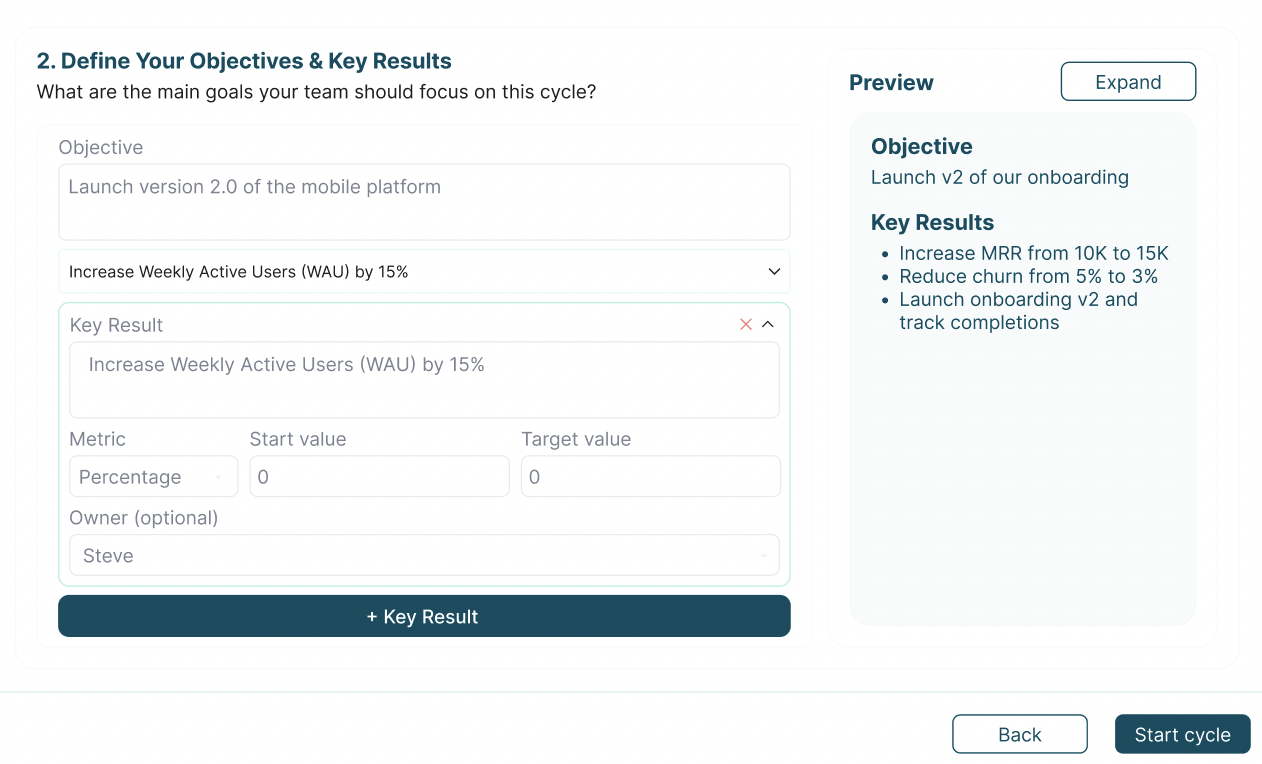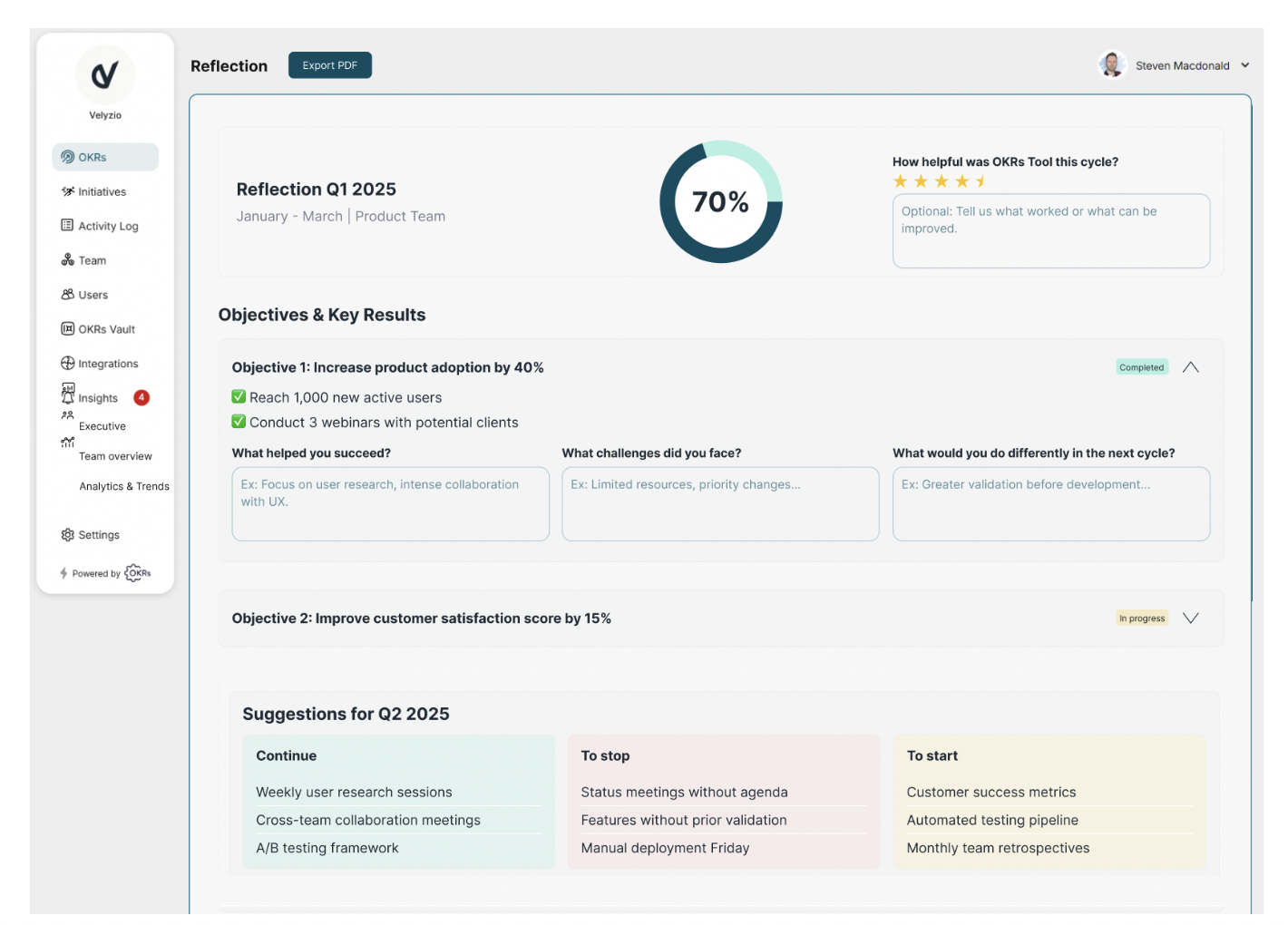Setting ambitious goals is easy. Keeping a growing team aligned around them?
That’s where most startups start to struggle.
As your company scales, priorities multiply, communication frays, and progress gets buried in Slack threads, spreadsheets, or someone’s memory. Suddenly, what felt like momentum turns into noise - and nobody’s quite sure what matters most.
The challenge isn’t a lack of vision. It’s the lack of a system to turn that vision into shared, measurable progress.
Organizing your OKRs (Objectives and Key Results) gives your team the structure it needs to move in the same direction - without slowing down. But the process doesn’t have to be complicated, expensive, or consultant-led.
In fact, the best OKR systems are the ones that get out of your way and let your team focus on the work that actually moves the needle.
This guide breaks down how to organize OKRs the smart way - especially if you’re building fast, wearing too many hats, and need a system your team will actually use.
Let’s Get Practical: What Smart OKR Setup Looks Like
Ambition is never the problem - execution is.
So how do you actually organize OKRs in a way that works for your team, not just in theory but in real time? Here’s where to start.
1. Start With the Right Foundation: Why OKRs Matter
Before jumping into logistics, it's important to clarify why OKRs work. The OKR framework helps teams align around what matters most by clearly articulating:
- Objectives: Where you want to go (your strategic goals)
- Key Results: How you'll measure success (specific, measurable outcomes)
What makes OKRs effective isn’t the framework itself - it’s how you organize and use them as a living system, not a one-time planning ritual.
2. Set Company-Level OKRs First
Start by defining 1–3 high-level objectives for your company. These should reflect your most critical priorities for the quarter or half-year, such as:
- Launch our new product successfully
- Grow monthly recurring revenue by 30%
- Improve customer retention and satisfaction
Then attach 2–4 measurable key results to each objective. For example:
These company-level OKRs become your team’s North Star. Everything else should ladder up to them.
3. Cascade (Lightly) to Teams and Individuals
Once your company OKRs are set, allow team leads or cross-functional groups to define supporting OKRs that directly align. The goal is to cascade without micromanaging.
Let’s say your company objective is to improve customer retention. Your customer success team might own an OKR like:
This keeps teams focused on outcomes that matter - without assigning tasks or creating a bloated hierarchy of sub-goals. The golden rule: every OKR should trace back to the bigger picture.
4. Choose the Right Tool (Hint: Spreadsheets Are Not the Answer)
Many startups begin organizing OKRs in Google Sheets or Notion. It feels flexible - until it isn’t.
Manual systems quickly break down as you grow:
- Updates get buried in email threads
- Versions get out of sync
- No one’s sure who owns what
That’s where a dedicated, startup-friendly tool like OKRs Tool comes in. Unlike bloated enterprise platforms, OKRs Tool gives you:
- A clean, intuitive dashboard to set and track OKRs
- Real-time progress visibility
- Flat team-based pricing (no per-user fees)
- Built-in templates and AI assistance for goal writing
- No need for consultants or complicated setup
With the right platform, organizing OKRs becomes a 15-minute process - not a month-long strategy offsite.

5. Assign Clear Ownership
An OKR without an owner is a wish, not a plan.
Every key result should have a directly responsible individual - not a team, not a department, but a name. Ownership creates accountability and encourages proactive tracking.
That doesn’t mean they have to achieve the result alone. But it does mean they’re responsible for moving it forward, coordinating efforts, and reporting progress.
In OKRs Tool, you can assign owners with one click - so there’s never confusion about who’s doing what.

6. Keep OKRs Visible (and Alive)
Too many startups set OKRs… and then forget about them.
OKRs aren’t helpful if they live in a document no one checks. For OKRs to drive real change, they must be:
- Easy to access
- Updated regularly
- Reviewed consistently
Here’s a simple cadence:
- Weekly: Quick check-ins to mark progress and surface blockers
- Monthly: Deeper reviews to assess alignment and make adjustments
- Quarterly: Retrospectives to evaluate performance and reset goals
Using a tool with built-in tracking (like OKRs Tool) makes this rhythm easy. You get real-time visibility into goal progress - without weekly meetings or micromanagement.
7. Don’t Overdo It
One of the most common OKR mistakes? Trying to do too much.
Stick to a maximum of 3–4 objectives per team or person, each with 2–4 key results. This forces prioritization and focus.
More OKRs ≠ more progress. In fact, spreading your team across too many goals leads to dilution and burnout. As we say at OKRs Tool: start simple, scale smoothly.
8. Use Templates and AI to Speed Up Setup
If you’re not sure how to write good OKRs, don’t start from scratch.
OKRs Tool includes pre-built templates and an AI goal assistant to help you craft OKRs in plain language. You simply input your priorities, and the platform suggests clear objectives and measurable key results.
This saves time, reduces friction, and ensures your OKRs are actionable - not vague statements of intent.

9. Link OKRs to Real Work (Not Just Strategy)
The best-organized OKRs are connected to daily execution. That means:
- Linking key results to actual projects, tasks, or metrics
- Tracking progress in real time (not just at quarter’s end)
- Using OKRs as a lens for prioritization
This connection between strategy and action is where many startups fall short. With OKRs Tool, you can sync OKRs with team workflows and dashboards, ensuring they stay relevant and useful week to week.
10. Review and Evolve Every Cycle
At the end of each OKR cycle, gather your team and reflect:
- What did we achieve?
- What got stuck?
- What needs to change next cycle?
Use these insights to improve your OKR process. Maybe you need fewer goals. Maybe you need clearer owners. Maybe you need to rethink how you measure progress.
OKRs are iterative. Don’t aim for perfection - aim for momentum.

Quick Reference: How to Organize OKRs (At a Glance)
If you're short on time or want a simple checklist to follow, here's a quick-reference guide to organizing OKRs effectively - especially in a fast-moving startup environment.
Each step aligns with the principles we've covered above and is designed to help you focus, stay aligned, and execute without unnecessary complexity.
This table can double as your team’s first OKR planning playbook. Whether you print it, share it in Slack, or turn it into a shared doc, it gives your team a clear roadmap for staying aligned without needing a consultant - or a complex platform.
Final Thoughts: Clarity Without Complexity
Organizing OKRs isn’t about frameworks or jargon - it’s about creating clarity across your team. When done right, OKRs bring focus, alignment, and accountability to your startup, without slowing you down.
Here’s what to remember:
- Start with company-wide OKRs, then cascade lightly
- Use a dedicated OKR tool to stay organized and visible
- Keep OKRs simple, measurable, and focused
- Assign ownership and track progress regularly
- Review and improve with each cycle
If your current goal-setting process feels scattered, slow, or overly complex, you’re not alone. Many early-stage teams outgrow spreadsheets and makeshift systems long before they realize it.
The good news is, with a bit of structure and a system that fits the pace of a startup, OKRs can shift from yet another task to a core part of how your team works - helping you stay focused, move faster, and scale with less friction and more clarity.






